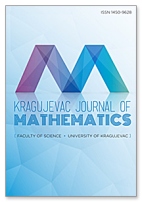Certain Classes of Bi-Univalent Functions of Complex Order Associated with Quasi-Subordination Involving $(p, q)$-Derivative Operator
 Download PDF
Download PDF
Authors: S. ALTıNKAYA AND S. YALçıN
DOI: 10.46793/KgJMat2004.639A
Abstract:
In this present paper, as applications of the post-quantum calculus known as the (p,q)-calculus, we construct a new class Dp,qk of bi-univalent functions of complex order defined in the open unit disk. Coefficients inequalities and several special consequences of the results are obtained.
of bi-univalent functions of complex order defined in the open unit disk. Coefficients inequalities and several special consequences of the results are obtained.
Keywords:
Coefficient bounds, Bi-univalent functions, Quasi-subordination, q-calculus, (p,q)-derivative operator.
References:
[1] Ş. Altınkaya and S. Yalçın, Faber polynomial coefficient bounds for a subclass of bi-univalent functions, C. R. Math. Acad. Sci. Paris 353 (2015), 1075–1080.
[2] S. Araci, U. Duran, M. Acikgoz and H. M. Srivastava, A certain (p,q)-derivative operator and associated divided differences, J. Inequal. Appl. 301 (2016), 2016, 8 pages.
[3] S. M. Aydoğan, Y. Kahramaner and Y. Polatoğlu, Close-to-convex functions defined by fractional operator, Appl. Math. Sci. 7 (2013), 2769–2775.
[4] D. A. Brannan and J. G. Clunie, Aspects of contemporary complex analysis, in: Proceedings of the NATO Advanced Study Instute, University of Durham, New York, 1979.
[5] D. A. Brannan and T. S. Taha, On some classes of bi-univalent functions, Stud. Univ. Babes-Bolyai Math. 31 (1986), 70–77.
[6] R. Chakrabarti and R. Jagannathan, A (p,q)-oscillator realization of two-parameter quantum algebras, J. Phys. A. 24 (1991), 711–718.
[7] P. L. Duren, Univalent Functions, Grundlehren der Mathematischen Wissenschaften 259, Springer-Verlag, Berlin, Heidelberg, New York, Tokyo, 1983.
[8] G. Gasper and M. Rahman, Basic Hypergeometric Series, Cambridge University Press, Cambridge, MA, 1990.
[9] S. G. Hamidi and J. M. Jahangiri, Faber polynomial coefficients of bi-subordinate functions, C. R. Math. Acad. Sci. Paris 354(2016), 365–370.
[10] T. Hayami and S. Owa, Coefficient bounds for bi-univalent functions, Pan-American Mathematical Journal 22 (2012), 15–26.
[11] F. H. Jackson, On q-functions and a certain difference operator, Transactions of the Royal Society of Edinburgh 46 (1908), 253–281.
[12] M. Lewin, On a coefficient problem for bi-univalent functions, Proc. Amer. Math. Soc. 18 (1967), 63–68.
[13] T. H. MacGregor, Majorization by univalent functions, Duke Math. J. 34 (1967), 95–102.
[14] A. Mohammed and M. Darus, A generalized operator involving the q-hypergeometric function, Mat. Vesnik 65 (2013), 454–465.
[15] F. M. Sakar and H. Ö. Güney, Faber polynomial coeffıcient bounds for analytıc bi-close-to-convex functions defıned by fractional calculus, J. Fract. Calc. Appl. 9 (2018), 64–71.
[16] E. Netanyahu, The minimal distance of the image boundary from the origin and the second coefficient of a univalent function in  < 1, Arch. Ration. Mech. Anal. 32 (1969), 100–112.
< 1, Arch. Ration. Mech. Anal. 32 (1969), 100–112.
[17] T. Panigarhi and G. Murugusundaramoorthy, Coefficient bounds for bi-univalent functions analytic functions associated with Hohlov operator, Proc. Jangjeon Math. Soc. 16 (2013), 91–100.
[18] Ch. Pommerenke, Univalent Functions, Vandenhoeck and Rupercht, Gottingen, 1975.
[19] S. D. Purohit and R. K. Raina, Certain subclass of analytic functions associated with fractional q-calculus operators, Math. Scand. 109 (2011), 55–70.
[20] S. D. Purohit and R. K. Raina, Fractional q-calculus and certain subclass of univalent analytic functions, Mathematica (Cluj) 55 (2013), 62–74.
[21] R. K. Raina and P. Sharma, Subordination properties of univalent functions involving a new class of operators, Electron. J. Math. Anal. Appl. 2 (2014), 37–52.
[22] F. Y. Ren, S. Owa and S. Fukui, Some inequalities on quasi-subordinate functions, Bull. Aust. Math. Soc. 43 (1991), 317–324.
[23] M. S. Robertson, Quasi-subordination and coefficients conjectures, Bull. Amer. Math. Soc. 76 (1970), 1–9.
[24] G. S. Salagean, Subclasses of univalent functions, in: Proceeding of Complex Analysis - Fifth Romanian Finnish Seminar, Part 1, Bucharest, 1981, Lecture Notes in Math. 1013, Springer, Berlin, 1983, 362–372.
[25] C. Selvaraj, G. Thirupathi and E. Umadevi, Certain classes of analytic functions involving a family of generalized differential operators, Transylvanian Journal of Mathemtics and Mechanics 9 (2017), 51–61.
[26] P. Sharma, R. K. Raina and J. Sokol, On the convolution of a finite number of analytic functions involving a generalized Srivastava–Attiya operator, Mediterr. J. Math. 13 (2016), 1535–1553.
[27] D. F. Sofonea, Some properties in q-calculus, Gen. Math. 16 (2008), 47–54.
[28] H. M. Srivastava, G. Murugusundaramoorthy and N. Magesh, Certain subclasses of bi-univalent functions associated with the Hohlov operator, Appl. Math. Lett. 1 (2013), 67–73.
[29] H. M. Srivastava, A. K. Mishra and P. Gochhayat, Certain subclasses of analytic and bi-univalent functions, Appl. Math. Lett. 23 (2010), 1188–1192.
[30] H. M. Srivastava, Univalent functions, fractional calculus, and associated generalized hypergeometric functions, in: H. M. Srivastava and S. Owa (Eds.), Univalent Functions, Fractional Calculus and Their Applications, Halsted Press (Ellis Horwood Limited, Chichester), John Wiley and Sons, New York, Chichester, Brisbane, Toronto, 1989.
[31] A. Zireh, E. A. Adegani and S. Bulut, Faber polynomial coefficient estimates for a comprehensive subclass of analytic bi-univalent functions defined by subordination, Bull. Belg. Math. Soc. Simon Stevin 23 (2016), 487–504.
